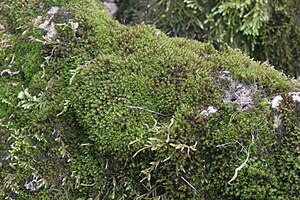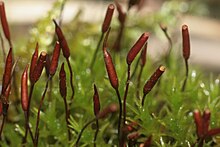Vaginal double tooth moss
| Vaginal double tooth moss | ||||||||||||
|---|---|---|---|---|---|---|---|---|---|---|---|---|

Vaginal double-tooth moss ( Didymodon spadiceus ) |
||||||||||||
| Systematics | ||||||||||||
|
||||||||||||
| Scientific name | ||||||||||||
| Didymodon spadiceus | ||||||||||||
| ( Mitt. ) Limpr. |
The vaginal double toothed Moss ( Didymodon spadiceus ) is a moss -Art from the family pottiaceae . Depending on the author, it is also called Barbula spadicea (Mitt.) Braithw.
features
The vaginal double tooth moss grows in loose, dark green to dirty green or brownish green lawns. The up to 7 centimeters high stems are not very branched. The leaves are lanceolate and long, pointed, upright to horizontally protruding when moist, loosely fitting and twisted when dry. The leaf margins are bent back in the lower half of the leaf. The leaf vein extends to the tip of the leaf and has narrow, elongated cells on its upper side. In the upper part of the leaf, the lamina cells are usually round, square, also triangular or oval, papilose and about 7 to 12 µm in size, at the leaf base they are rectangular and transparent.
The sporophytes have a red, 1 to 1.5 centimeter high seta and an upright, cylindrical capsule with a long beaked lid and short, more or less upright peristome teeth . The spores are greenish, granular and 10 to 16 µm in size. The plants are diocesan .
Locations and occurrences
The moss grows on shady to partially shaded, moist to wet calcareous rocks, stones or sandstone, mainly on streams and rivers, but also in forest ravines and rocky steep slopes. In addition to Europe, it also occurs in parts of Asia and North America. It is widespread in Central Europe and occurs mainly in the low mountain ranges and the Alps.
literature
- Jan-Peter Frahm , Wolfgang Frey : Moosflora (= UTB . 1250). 4th, revised and expanded edition. Ulmer, Stuttgart 2004, ISBN 3-8252-1250-5 .
- Martin Nebel, Georg Philippi (ed.): The mosses of Baden-Württemberg. Volume 1: General part, special part (Bryophytina I, Andreaeales to Funariales). Ulmer, Stuttgart 2000, ISBN 3-8001-3527-2 .
